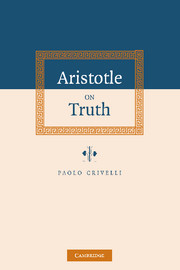Book contents
- Frontmatter
- Contents
- Acknowledgements
- Notes on the text
- List of abbreviations of titles of Aristotle's works
- Introduction
- Part I BEARERS OF TRUTH OR FALSEHOOD
- Part II ‘EMPTY’ TERMS
- Part III TRUTH AND TIME
- Appendix 1 Metaph. Θ 10, 1051b1: the text
- Appendix 2 Metaph. Θ 10, 1051b2–3: the text
- Appendix 3 Int. 7, 17b16–18: the text
- Appendix 4 The two-place relations in Aristotle's definition of truth
- Appendix 5 Aristotle's theory of truth for predicative assertions: formal presentation
- Appendix 6 The failure of bivalence for future-tense assertions: formal presentation
- References
- Index of names
- Index of subjects
- Index of passages
Appendix 6 - The failure of bivalence for future-tense assertions: formal presentation
Published online by Cambridge University Press: 22 September 2009
- Frontmatter
- Contents
- Acknowledgements
- Notes on the text
- List of abbreviations of titles of Aristotle's works
- Introduction
- Part I BEARERS OF TRUTH OR FALSEHOOD
- Part II ‘EMPTY’ TERMS
- Part III TRUTH AND TIME
- Appendix 1 Metaph. Θ 10, 1051b1: the text
- Appendix 2 Metaph. Θ 10, 1051b2–3: the text
- Appendix 3 Int. 7, 17b16–18: the text
- Appendix 4 The two-place relations in Aristotle's definition of truth
- Appendix 5 Aristotle's theory of truth for predicative assertions: formal presentation
- Appendix 6 The failure of bivalence for future-tense assertions: formal presentation
- References
- Index of names
- Index of subjects
- Index of passages
Summary
Is Aristotle coherent? Aristotle's position in Int. 9 has been taken to be incoherent. For Aristotle accepts Excluded Middle (which involves endorsing every instance of ‘α ∨ ¬α’) but denies Bivalence (which involves denying that at every time every assertion is either true or false). It is hard to see how this could be coherent – but the following formal semantic theory shows that it is.
Expanded semantic theory Appendix 5 contained a formal presentation of a semantic theory for a fragment of natural language that includes some present-tense predicative assertions. Here, in appendix 6, this semantic theory is expanded. The expanded semantic theory covers a slightly larger fragment of natural language, a fragment including not only some present-tense predicative assertions, but also some past- and future-tense predicative assertions, some ‘tomorrow’-assertions (i.e. predicative assertions that begin with an utterance of the phrase ‘tomorrow it will be the case that’), and some negative and disjunctive assertions.
Expansion of the alphabet The alphabet of the semantic theory presented in appendix 5, described in [54] and [55], must be expanded.
- Type
- Chapter
- Information
- Aristotle on Truth , pp. 266 - 283Publisher: Cambridge University PressPrint publication year: 2004



